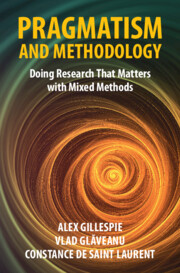510 results
Introduction
-
- Book:
- Hard Lessons in Corporate Governance
- Published online:
- 23 May 2024
- Print publication:
- 30 May 2024, pp 1-16
-
- Chapter
- Export citation
Chapter 1 - Why a New Direction Is Necessary
- from Part I - Collaborative Competence
-
- Book:
- Developing Together
- Published online:
- 07 May 2024
- Print publication:
- 09 May 2024, pp 3-25
-
- Chapter
- Export citation
Chapter 1 - Introduction
-
- Book:
- Popular Culture and the End of Antiquity in Southern Gaul, c. 400–550
- Published online:
- 15 March 2024
- Print publication:
- 28 March 2024, pp 1-35
-
- Chapter
- Export citation
Bioethics: No Method—No Discipline?
-
- Journal:
- Cambridge Quarterly of Healthcare Ethics , First View
- Published online by Cambridge University Press:
- 22 March 2024, pp. 1-10
-
- Article
-
- You have access
- Open access
- HTML
- Export citation
1 - Religious Ethics and Obligations to Others
-
- Book:
- On Helping One's Neighbor
- Published online:
- 04 April 2024
- Print publication:
- 14 March 2024, pp 1-42
-
- Chapter
- Export citation
Chapter 7 - The Tractatus and the First Person
-
-
- Book:
- Wittgenstein's <I>Tractatus Logico-Philosophicus</I>
- Published online:
- 07 March 2024
- Print publication:
- 14 March 2024, pp 125-144
-
- Chapter
- Export citation
Introduction
-
- Book:
- The Duty to Secure
- Published online:
- 15 February 2024
- Print publication:
- 22 February 2024, pp 1-41
-
- Chapter
-
- You have access
- HTML
- Export citation
Attitudes toward automation and the demand for policies addressing job loss: the effects of information about trade-offs
-
- Journal:
- Political Science Research and Methods , First View
- Published online by Cambridge University Press:
- 15 February 2024, pp. 1-16
-
- Article
-
- You have access
- Open access
- HTML
- Export citation
The Methodologically Flawed Discussion about Deep Disagreement
-
- Journal:
- Episteme , First View
- Published online by Cambridge University Press:
- 05 February 2024, pp. 1-17
-
- Article
-
- You have access
- Open access
- HTML
- Export citation
Introduction
-
- Book:
- Collective Self-Defence in International Law
- Published online:
- 04 January 2024
- Print publication:
- 25 January 2024, pp 1-22
-
- Chapter
- Export citation
1 - Introduction
-
- Book:
- Academic Freedom and the Transnational Production of Knowledge
- Published online:
- 04 January 2024
- Print publication:
- 25 January 2024, pp 1-14
-
- Chapter
- Export citation

Pragmatism and Methodology
- Doing Research That Matters with Mixed Methods
-
- Published online:
- 04 January 2024
- Print publication:
- 25 January 2024
-
- Book
-
- You have access
- Open access
- Export citation
A true crime story: The role of space, time, and identity in narrating criminal authority
-
- Journal:
- European Journal of International Security / Volume 9 / Issue 2 / May 2024
- Published online by Cambridge University Press:
- 22 December 2023, pp. 180-198
- Print publication:
- May 2024
-
- Article
-
- You have access
- Open access
- HTML
- Export citation
8 - Domestic Carbon Offset Scheme
- from Part IV - Adopting Carbon Removal Mechanisms
-
- Book:
- In Pursuit of Carbon Neutrality
- Published online:
- 07 December 2023
- Print publication:
- 21 December 2023, pp 145-164
-
- Chapter
- Export citation
Quantitative Inquiry in the Early Sociology of W. E. B. Du Bois
-
- Journal:
- Du Bois Review: Social Science Research on Race , First View
- Published online by Cambridge University Press:
- 13 December 2023, pp. 1-23
-
- Article
-
- You have access
- Open access
- HTML
- Export citation
Introduction
-
- Book:
- Flemish Textile Workers in England, 1331–1400
- Published online:
- 16 November 2023
- Print publication:
- 30 November 2023, pp 1-34
-
- Chapter
- Export citation
Introduction: Before a Vast Ocean
-
- Book:
- China and the Philippines
- Published online:
- 09 November 2023
- Print publication:
- 23 November 2023, pp 1-20
-
- Chapter
- Export citation
Introduction
-
- Book:
- Old Age and American Slavery
- Published online:
- 27 October 2023
- Print publication:
- 16 November 2023, pp 1-30
-
- Chapter
- Export citation
Negotiating regime complexity: Following a regime complex in the making
-
- Journal:
- Review of International Studies / Volume 50 / Issue 2 / March 2024
- Published online by Cambridge University Press:
- 16 November 2023, pp. 231-251
- Print publication:
- March 2024
-
- Article
-
- You have access
- Open access
- HTML
- Export citation
Questioning the Appropriateness of Examining Guanxi in a Wasta Environment: Why Context Should Be Front and Center in Informal Network Research – A Commentary on ‘De-Linking From Western Epistemologies: Using Guanxi-Type Relationships to Attract and Retain Hotel Guests in the Middle East’
-
- Journal:
- Management and Organization Review / Volume 19 / Issue 5 / October 2023
- Published online by Cambridge University Press:
- 09 November 2023, pp. 1040-1045
-
- Article
-
- You have access
- Open access
- HTML
- Export citation



